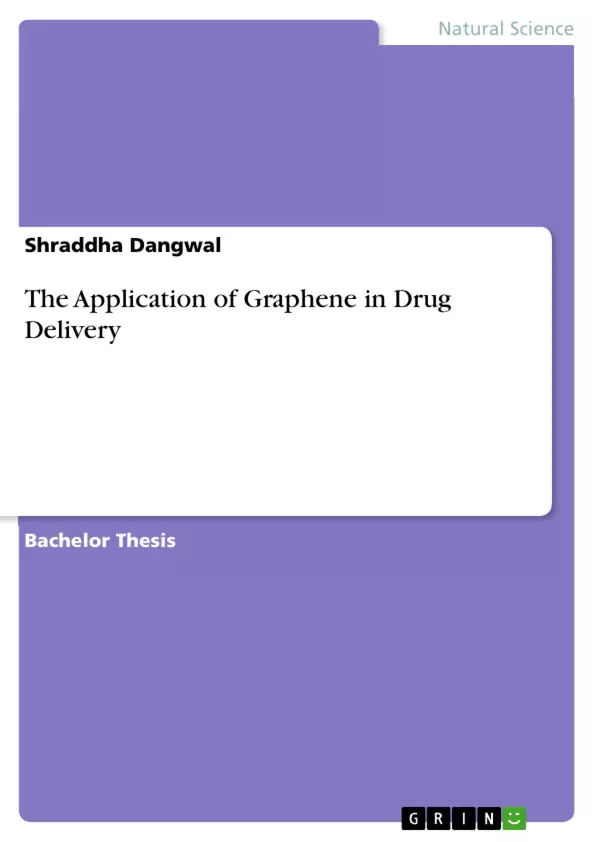In this review, Graphene in the context of its application in the drug delivery system will be analysed. Graphene was first isolated using mechanical exfoliation within the now famous ‘scotch-tape method’. The benzene-like structure of the hexagonal components of the lattice allows it to be thought of like a giant aromatic poly-molecule. Even without further functionalisation, this structure provides useful properties in the delivery method: aromatic molecules may bind to graphene through non-covalent interactions between carbon-rings and the large relative surface area of 2D geometry permits a single graphene flake to be decorated with a raft of different aromatic groups.
Inhaltsverzeichnis (Table of Contents)
- ABSTRACT
- 1. INTRODUCTION
- 2. HISTORY
- 3. STRUCTURE OF GRAPHENE
- 4. PROPERTIES OF GRAPHENE
- 4.1. Micromechanical Cleavage
- 4.2. Liquid Phase Exfoliation
- 4.3. Chemical Vapour Deposition
- 4.4. Chemical Methods
- 4.5. Mechanical Properties
- 4.6. Electrical Properties
- 5. APPLICATIONS OF GRAPHENE FOR REAL-TIME APPLICATIONS
- 5.1. Flexible Graphene Transistors
- 5.2.Graphene Sensors
- 5.3. Graphene for lithiumesulfur (LieS) battery
- 5.4. Graphene displays
- 5.5. Structural Composites
- 5.6. Catalysts Support
- 5.6. Polymer Masterbatches
- 5.7. Functional Inks
- 6. Use of Graphene for COVID
- 6.1. Graphene-based anti-viral surfaces and coatings
- 6.2.Graphene-based electrochemical biosensors
- 6.3. Graphene-based Field-effect Transistor for Biosensing
- 6.4. Graphene-based Piezoelectric Biosensors
- 6.5. Graphene based on Gene-editing Technology (CRISPR/Cas)
- 6.6. Multilayer Graphene Nanofoams
- 7. CONCLUSION AND CHALLENGES
- 8. WAY FORWARD
- REFERENCES
Zielsetzung und Themenschwerpunkte (Objectives and Key Themes)
This review focuses on the application of graphene in drug delivery systems. It delves into the history of graphene, its unique properties, and its diverse applications in various fields. The paper highlights the potential of graphene in developing new drug delivery strategies.
- Properties of graphene and its potential in drug delivery systems
- Graphene's application in real-time applications like transistors, sensors, and batteries
- Graphene's use in addressing the COVID-19 pandemic, including antiviral surfaces and coatings, biosensors, and gene-editing technology
- The challenges and future directions of graphene research and development
- The significance of graphene in the field of nanotechnology and its potential for revolutionizing various industries
Zusammenfassung der Kapitel (Chapter Summaries)
- ABSTRACT: Provides a concise overview of graphene, its unique properties, and its potential in drug delivery.
- 1. INTRODUCTION: Introduces graphene as a single atom-thick, nanosized 2D structure with high surface area and adjustable surface chemistry, making it suitable for hybrid materials. The text explores the use of graphene in drug delivery systems, referencing the famous 'scotch-tape method' for its isolation.
- 2. HISTORY: Traces the discovery of graphene by Geim and Novoselov through the 'scotch-tape method' and explores its origins as the building block of carbon nanotubes and graphite. The chapter highlights the historical development of graphene research, from its early observations to the breakthrough discovery of its unique properties.
- 3. STRUCTURE OF GRAPHENE: Explains the hexagonal structure of graphene, consisting of sp^2 hybridised carbon atoms. It provides a detailed explanation of the lattice structure of graphene.
- 4. PROPERTIES OF GRAPHENE: Discusses the various properties of graphene, including its mechanical, electrical, and chemical properties. It explores different methods of graphene production, such as micromechanical cleavage, liquid phase exfoliation, chemical vapor deposition, and chemical methods.
- 5. APPLICATIONS OF GRAPHENE FOR REAL-TIME APPLICATIONS: Covers a wide range of applications of graphene in real-time applications, including flexible transistors, sensors, lithium-sulfur batteries, displays, structural composites, catalysts support, polymer masterbatches, and functional inks.
- 6. Use of Graphene for COVID: Explores the use of graphene in combating the COVID-19 pandemic, focusing on its application in antiviral surfaces and coatings, electrochemical biosensors, field-effect transistors for biosensing, piezoelectric biosensors, gene-editing technology, and multilayer graphene nanofoams.
Schlüsselwörter (Keywords)
Graphene, drug delivery, Scotch-tape method, properties, SARS-COV-2, respiratory synctial virus (RSV), COVID-19, nanotechnology, antiviral surfaces, biosensors, gene-editing technology, multilayer graphene nanofoams.
- Citation du texte
- Shraddha Dangwal (Auteur), 2021, The Application of Graphene in Drug Delivery, Munich, GRIN Verlag, https://www.grin.com/document/1153475



